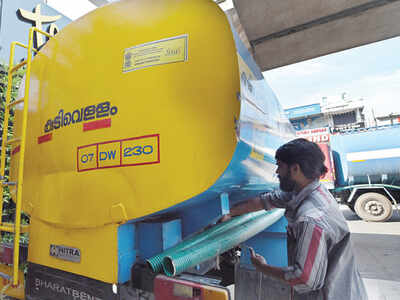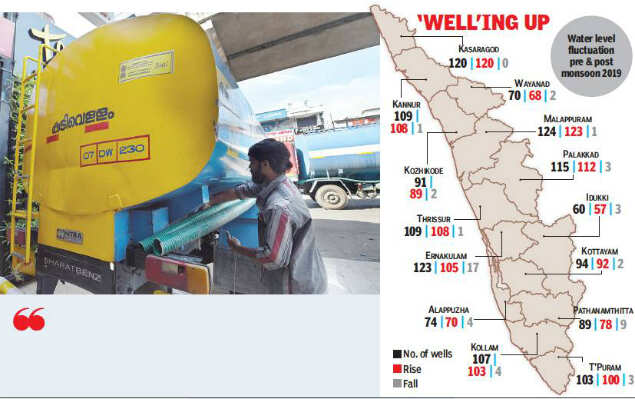
KOCHI: Groundwater levels in the state have been fluctuating for the last two years, with intense yet erratic rainfall recharging the water table. For the second consecutive year, groundwater levels rose by as much as 4 metres in some districts, according to data collated by the central ground water board (CGWB).
According to the CGWB’s November 2019 report on groundwater levels submitted to the state government, nearly 80% of the annually monitored wells have seen a rise in water levels. Of the total 1,388 monitored wells, 1,333 registered a rise while 52 recorded a fall. A spike of more than 4 metres was reported in isolated pockets of Kasaragod, Kollam, Alappuzha, Malappuram, Palakkad, Thrissur and Pathanamthitta districts while a decline of the same measure was noted in a few locations in Kannur, Malappuram, Thiruvananthapuram and Wayanad.

CGWB officials said the comparison of data between the water levels of November 2018 and 2019 showed a rise in the order of 0.01 to 10.79 metres below ground level (mbgl) with a fall in the order of 0.01 to 8.94 mbgl. Among the monitored wells, 79.69% registered a rise, while 19.08% posted a fall.
Experts says that more than 60% of the wells dug in the state are not being used or even properly maintained.
“With the arrival of piped water, most people just abandoned their wells; which soon got contaminated because of the lack of cleaning activity. The well ecosystem is a robust one. Ideally, these can be revived through what is called point recharging. All one must do is orient or direct the rainwater into them. In one’s own backyard, you can construct small stone bunds or vegetative embarkments to direct the water into the well. The water is saved through the efficiency of infiltration. Even a minor slope of just one centimetre can direct the water elsewhere,” said Sunny George, director, SCMS water institute.
The shallow water level was seen in the range of 0-2 mbgl in Alappuzha, the coastal tracts of Ernakulam, Kollam, Thrissur and Kozhikode districts, as well as in the valleys of eastern Idukki, Palakkad, Wayanad and Kozhikode districts. The water level in the midlands ranged from 2-10 mbgl. Interestingly, a water level of more than 20 mbgl was noted in patches in Thiruvananthapuram, Palakkad and Kasaragod districts.
A comparison of water levels post monsoon in November 2019 with that of pre monsoon in April 2019 indicated a rise in the range of 0-14.10 metres in most parts of the state, whereas fall in water level was noticed in certain small isolated pockets mainly in Ernakulam, Thrissur, Kottayam, Pathanamthitta and Alappuzha districts. A fall in the water level, in the range of 0-4 metres, was noticed in isolated patches in Alappuzha and Ernakulam, Kannur, Malappuram and Thrissur districts.
“There’s a concept of sanitized wells. We need to take an inventory of wells in each local body and sanitize them. We have 46 lakh wells in Kerala, one of the highest in the world. It is like 200 wells per square kilometre, which is something we have completely ignored. These wells can be sanitized and used as recharge points,” George said.
According to the CGWB’s November 2019 report on groundwater levels submitted to the state government, nearly 80% of the annually monitored wells have seen a rise in water levels. Of the total 1,388 monitored wells, 1,333 registered a rise while 52 recorded a fall. A spike of more than 4 metres was reported in isolated pockets of Kasaragod, Kollam, Alappuzha, Malappuram, Palakkad, Thrissur and Pathanamthitta districts while a decline of the same measure was noted in a few locations in Kannur, Malappuram, Thiruvananthapuram and Wayanad.

CGWB officials said the comparison of data between the water levels of November 2018 and 2019 showed a rise in the order of 0.01 to 10.79 metres below ground level (mbgl) with a fall in the order of 0.01 to 8.94 mbgl. Among the monitored wells, 79.69% registered a rise, while 19.08% posted a fall.
Experts says that more than 60% of the wells dug in the state are not being used or even properly maintained.
“With the arrival of piped water, most people just abandoned their wells; which soon got contaminated because of the lack of cleaning activity. The well ecosystem is a robust one. Ideally, these can be revived through what is called point recharging. All one must do is orient or direct the rainwater into them. In one’s own backyard, you can construct small stone bunds or vegetative embarkments to direct the water into the well. The water is saved through the efficiency of infiltration. Even a minor slope of just one centimetre can direct the water elsewhere,” said Sunny George, director, SCMS water institute.
The shallow water level was seen in the range of 0-2 mbgl in Alappuzha, the coastal tracts of Ernakulam, Kollam, Thrissur and Kozhikode districts, as well as in the valleys of eastern Idukki, Palakkad, Wayanad and Kozhikode districts. The water level in the midlands ranged from 2-10 mbgl. Interestingly, a water level of more than 20 mbgl was noted in patches in Thiruvananthapuram, Palakkad and Kasaragod districts.
A comparison of water levels post monsoon in November 2019 with that of pre monsoon in April 2019 indicated a rise in the range of 0-14.10 metres in most parts of the state, whereas fall in water level was noticed in certain small isolated pockets mainly in Ernakulam, Thrissur, Kottayam, Pathanamthitta and Alappuzha districts. A fall in the water level, in the range of 0-4 metres, was noticed in isolated patches in Alappuzha and Ernakulam, Kannur, Malappuram and Thrissur districts.
“There’s a concept of sanitized wells. We need to take an inventory of wells in each local body and sanitize them. We have 46 lakh wells in Kerala, one of the highest in the world. It is like 200 wells per square kilometre, which is something we have completely ignored. These wells can be sanitized and used as recharge points,” George said.
Trending Topics
LATEST VIDEOS
More from TOI
Navbharat Times
Featured Today in Travel
Get the app







